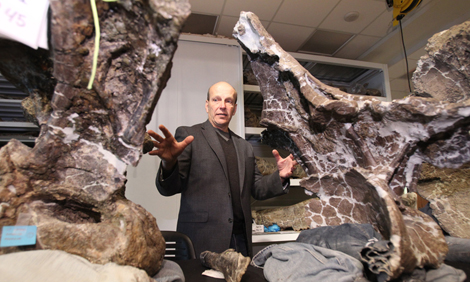


Scientist Kenneth Lacovara, who led the team that discovered the largest dinosaur, stands between two of its gigantic backbones.
The word “Dreadnought” literally means “fear nothing.” It is a term used to describe something that is the largest of its kind. Scientists have used this term to name the largest dinosaur discovered so far, the Dreadnoughtus schrani (dred•NAWT•us SHRAH•nee). When the Dreadnoughtus was alive, it weighed more than 130,000 pounds and was about 85 feet long. If you weighed more than a Boeing 737 airplane and were as wide as a hockey rink, you probably wouldn’t fear anything either. You would be at least six times the size of the famous Tyrannosaurus rex, or T. rex as it’s more commonly known.
The Dreadnoughtus lived about 97 million years ago. A skeleton of this massive dinosaur was dug up in Patagonia, a region at the southern end of South America. The Dreadnoughtus skeleton is the most complete ever found for a creature of its size. It’s possible that there’s a larger dinosaur that has not been discovered yet. However, until something bigger turns up, the Dreadnoughtus has the unofficial title of “world’s largest dinosaur.”
The Dreadnoughtus dinosaurs were herbivores, or plant eaters. Using their extremely long necks, they could eat from the tallest trees in the forests. They did not have the sharp teeth of carnivores, or meat eaters, but they could defend themselves with their huge tails. Scientists suspect that even the ferocious T. rex would not attack a Dreadnoughtus because of its incredible size and strength.
Kenneth Lacovara from Philadelphia’s Drexel University led the team of paleontologists who discovered the Dreadnoughtus. A paleontologist is a scientist who studies ancient life forms by examining fossils. Lacovara published information about the discovery in August of this year. He worked with the Carnegie Museum of Natural History in Pittsburgh to make 3-D scans of the bones. He put these scans on a website that anyone can access. This allows people across the globe to study the Dreadnoughtus’s remains.


























